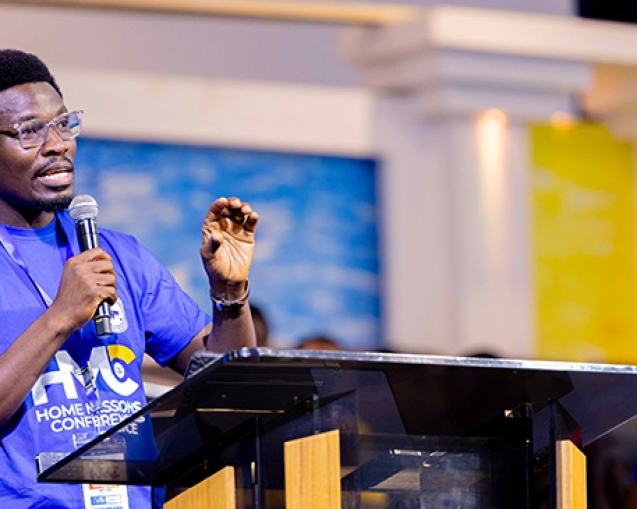INTRODUCTION
The Gospel of Christ is breath-taking. It has crossed barriers, unprecedented. It has defied all odds. This Christian evangel has demonstrated that it can penetrate anywhere, notwithstanding the resistance it may encounter. Bringing people to the saving knowledge of God has had a global orientation, even from the Old Testament. Although in the biblical narratives, we discover that he chose the nation of Israel as his peculiar people, his focus has been to reach out to all people and tongues despite their religio-cultural stance. Consequently, the mission of God is flourishing among non-religious people, primal religious people, and people who belong to the world religions, among others that may be. The Holy Spirit, who is the chief facilitator of missions, is by nature able to make entrance into every religio-cultural context, including the extremely difficult one. Some contexts have been rendered hopeless insofar as the Christian Gospel is concerned, but today, they have become places where Christianity is growing in leaps and bounds. The mission effort of The Church of Pentecost (CoP) has touched all continents of the world today. Beginning from Ghana and then to neighbouring nations, including Togo, Benin, La Cote d’Ivoire, and Burkina Faso, the CoP established churches. The work of missions to all continents continued. Today, the CoP is present in 170 nations of the world, including countries located between latitudes 10 degrees and 40 degrees north of the equator, where most of the unreached people groups with the Gospel lie. That rectangular part of the globe has come to be known as the 10/40 window in mission studies. It is marked as a hard ground for the Christian Gospel. Some demonologists claim that there is a strong demonic stronghold in that area, and as such, that zone of the world remains largely not evangelised. Notwithstanding, the CoP is breaking through the Window. With the understanding that the 10/40 Window is a place that is largely occupied by world religions, including Islam, Buddhism, Hinduism, and Judaism, among others, this essay shall proceed to point out the inspiring progress of the CoP within the Window. It will touch briefly on how the Christian faith spread in a strictly Judaist context in the Acts of the Apostles narrative to draw lessons. A cursory look at how Jesus Christ compares to Hinduism will also be done. It will be concluded by briefly considering the Gospel, who is Christ, in the light of Islam, another major religion within the 10/40 Window.
THROUGH THE 10/40 WINDOW AND INTO THE WORLD RELIGIONS
The term 10/40 Window was coined by Luis Bush, a missiologist. It spans northern Africa into Southern Asia, including the European part of the western hemisphere. It must be stated again that the countries that have been least evangelised are within this Window. Most of the unreached people groups of the world dwell there. Meanwhile, this window is home to most of the world’s population. It is difficult doing open evangelism there. This was known as the “resistant belt” in terms of resistance to the Gospel. Anti-Christian religious and governmental policies are rampant. As such, Christians suffer much physical persecution in these areas. The nature of the countries within the 10/40 Window concerning the spread of the Gospel has revealed the importance of missionary geography. Consequently, more mission effort is needed in this geographical area. Considering that the Great Commission encourages Christians to make disciples of all nations suggests that Christian missions must necessarily go on there.
In going through the 10/40 Window, the CoP has reached the United Arab Emirates, specifically Abu Dhabi and Dubai. Missionary incursion has been made into Pakistan, Qatar, Bahrain, Oman, Iraq, Kuwait, Egypt, Azerbaijan, Georgia, and Jordan. Other 10/40 Window countries that have been reached include Senegal, Japan, South Korea, Mali, Burkina Faso, China, Bangladesh, and Malta. Tunisia, India, Libya, Ethiopia, Guinea, Guinea Bissau, Thailand, The Gambia, Greece, Israel, Benin, Chad, Nepal, Niger, Cyprus, and Lebanon are also nations that lie within the Window to which the CoP has extended its missions effort. This is inspiring.
Extending its reach to these nations means that the CoP is navigating resistance from world religions, strict governmental laws, socio-economic challenges, folk religion, and atheism to bring the Gospel and Christian fellowship to indigenes and expatriates alike. It is of utmost importance that Christians are acquainted with how Christ stands among other religions.
REFLECTION ON THE SPREAD OF THE CHRISTIAN FAITH IN THE HEARTLAND OF JUDAISM
When the outpouring of the Holy Spirit was promised by the Lord Jesus Christ, he indicated to the early disciples that the work of missions, as it were, would take off from their immediate dwelling, Jerusalem, and spread out to the ends of the earth (Acts 1:8). Meanwhile, Jerusalem is the heartland of Judaism. Invariably, missions work will encounter world religions such as Islam, Judaism, Hinduism, and Buddhism, among others. Per religious studies, Christianity is classified among the world religions. But Christ is unique indeed! He is the hidden desire of all persons despite their religious orientation. A conversation between Christ and other religions will show that there are pointers to Christ in them that Christian missions must capitalise on in preaching the Gospel to all people.
We see from the Acts narrative that, empowered by the Holy Spirit, the early disciples made great strides in Jerusalem and beyond. However, the resistance to the preaching of Christ was enormous. The early Christians were held to be a messianic Jewish sect since, by that time, all of them were Jews who were preaching about Christ. They were considered as wanting to rise against established religion. This is because the early Christians preached that Jesus, who was crucified, was the Messiah the Jews had been expecting. They referred to the Jewish beliefs and practices as pointing to Jesus Christ so that Jesus becomes the desire of that world religion, though the religion is searching for Christ through a distorted lens. They announced that Jesus had resurrected from the dead and would eventually come to execute judgment on the world. This contradicts the messianic eschatology of the Jews, where a Davidic Messiah is being looked forward to come and execute judgment on the enemies of Israel. From where the Jews stood, the early Christians flouted the Mosaic covenant and respected the Temple worship. Consequently, the early Christians were sorely persecuted.
Meanwhile, the politics at the time was also a challenge to surmount. Then, Palestine fell to the Romans. Earlier, the Greeks ruled Palestine. The war campaigns of the Greeks reached Palestine, and the Jews became part of the Greek commonwealth. The ripple effects of the Greek revolution catalysed by Alexander the Great are still felt today. Alexander the Great had the vision of spreading Greek culture, religion, and philosophy worldwide. The events that animated the Hellenization regime lie in part in cultural pride and the quest for power and glory. After the period of wars of Alexander, the Hellenization of the Jews became more pronounced, and Christianity, which emerged from within this context, became substantially shaped by the process of Hellenization.
Therefore, the work of missions within a world religious context had to deal with religion, culture, and political tensions. The early Christians were resilient. Consequently, the missionary zeal became equated to “turning the world upside down” (Acts 17:6). This was how impactful their mission work was. Future generations have much to learn from them in the face of great resistance within the 10/40 Window.
JESUS CHRIST AND HINDUISM
One of the scholars who has been a strong voice in the call for a revised Christology (doctrine of Christ) was Stanley Jedidiah Samartha, the first director of the Committee for Dialogue with People of Living Faiths and Ideologies, a division of the World Council of Churches (WCC). In his book, One Christ⸺Many Religions: Towards a Revised Christology, he discussed extensively the place of Christ in other religions and calls for a rethinking of the historical Christology of the Christian faith by endorsing a theocentric Christology against a Christocentric Christology. By this, the uniqueness of Christ is sacrificed.
Samartha then delved into the Hindu context of India to find appropriate means for interreligious relationships. He established the significantly pluralistic context of India as a case for the necessity for a theology that fully accepts other faiths as salvific. He drew from principles in Hinduism to reject exclusivism and embrace pluralism. His point was that India, than any other country, “the claim for the uniqueness of one particular religious tradition . . . sound so rude, out of place, and theologically arrogant.” The Hindu context of India, therefore, becomes, significantly, the fountainhead of his concept of the “mystery of God” or theocentric theology.
Reflecting on God in the Hindu context to formulate a Christology that he is pushing down the throat of the entire Christian faith is uncalled for. Interestingly, he could not hide the fact that Jesus Christ permeates the works of art in India. This is not surprising. Jesus Christ is before all culture. That Christ is seen in the works of art among non-Christians is evidence of the uniqueness of Christ.
IN LIEU OF CONCLUSION: THE GOSPEL AND ISLAM IN A BRIEF CONVERSATION
From the backdrop of Islam being a main religion within the 10/40 Window. It is relevant we recognise pointers to Christ in that belief as well. These can be used as an important point of departure in the proclamation of the Gospel.
Many adherents of the Islamic religion take pride in the fact that they know more about the Bible and Christianity than an “average” Christian knows about Islam. Well, they are right. This is because, from a key point of view, there is a wide reference to Jesus (Isa) in the Qur’an. The family background of Jesus is key in the Qur’an. There is even a Qur’anic chapter named after Mary (Maryam), the mother of Jesus. The virginity of Mary was mentioned (Q21:91). The angelic visitation to Mary by angel Gabriel (Jibril) to announce that Mary (Maryam) will give birth to Jesus (Isa) was alluded to (Q19:17-19) as we see in Luke 1:26-38. Jesus (Isa) comes out in the Qur’an as a unique prophet (nabi) of God who performed some miracles. For instance, Jesus (Isa) spoke as a baby (Q19:3), and he created birds from clay by breathing life into clay models of clay, among others.
The Qur’an demonstrates that Jesus (Isa) is a messenger (rasul) of God who is the bearer of the Gospel (Injil). Just like in Matthew 5:17, where Jesus reveals that he has not come to destroy the Law to fulfil it, Q3:44 reveals that Jesus (Isa) came to announce the truth which has been said about him in the Torah or the Law. Jesus (Isa) is the Messiah (al-Masih) and the word of God (Q3:51) who speaks in God’s stead, as we see in John 1 as well. From the Christian perspective, Jesus Christ is the word of God. The Gospel is a person. This Gospel is translational or incarnational. As such, the Gospel can be translated into different contexts, unlike in Islam. Concerning Jesus as the Son of God, though Islam refutes his divinity and unity with God as demonstrated in the Bible, in the Qur’an, Jesus is referred to as being min at-Mukarrabin (close to the Lord).
From the foregoing discussion, it is apparent that the uniqueness of Christ abides. Even in this contemporary world of religious pluralism, the uniqueness of Jesus Christ cannot be denied. He is the one who permeates all that there is in the universe as far as our limited minds can fathom. He is the desire of the nations with their diverse religio-cultural emphases. In the face of cultural and political barriers, we must discover the unique Christ and preach him to the core within the parts of the world where other religions have taken root. The Holy Spirit, who inspires Christian missions, is not limited; he blows wherever he wills. May he continually grant the Church creative means of accessing these areas. This must inspire hope for the work of missions within the 10/40 Window. There is a lot of work to be done. The Great Commission must be on the go.
Written by Elder Dr. Stephen Ofotsu Ofoe


















